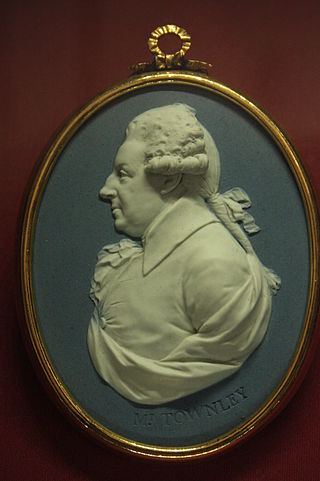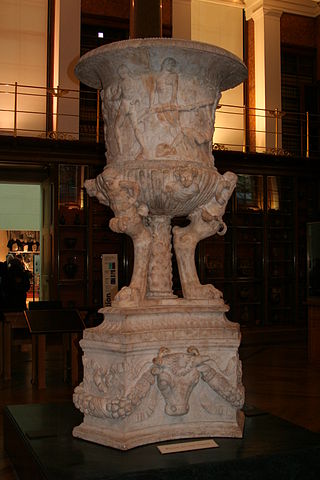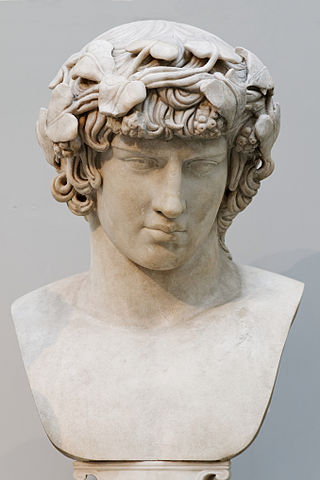
Charles Townley FRS was a wealthy English country gentleman, antiquary and collector, a member of the Towneley family. He travelled on three Grand Tours to Italy, buying antique sculpture, vases, coins, manuscripts and Old Master drawings and paintings. Many of the most important pieces from his collection, especially the Townley Marbles are now in the British Museum's Department of Greek and Roman Antiquities. The marbles were overshadowed at the time, and still today, by the Elgin Marbles.

A caryatid is a sculpted female figure serving as an architectural support taking the place of a column or a pillar supporting an entablature on her head. The Greek term karyatides literally means "maidens of Karyai", an ancient town on the Peloponnese. Karyai had a temple dedicated to the goddess Artemis in her aspect of Artemis Karyatis: "As Karyatis she rejoiced in the dances of the nut-tree village of Karyai, those Karyatides, who in their ecstatic round-dance carried on their heads baskets of live reeds, as if they were dancing plants".

"Ode on a Grecian Urn" is a poem written by the English Romantic poet John Keats in May 1819, first published anonymously in Annals of the Fine Arts for 1819.

The Discobolus of Myron is an Ancient Greek sculpture completed at the start of the Classical period at around 460–450 BC. The sculpture depicts a youthful male athlete throwing a discus. The bronze Greek original is lost. The work is known through its numerous Roman copies, both full-scale ones in marble, which is cheaper than bronze, such as the first to be recovered, the Palombara Discobolus, and smaller scaled versions in bronze.

Hadrian's Villa is a UNESCO World Heritage Site comprising the ruins and archaeological remains of a large villa complex built c. AD 120 by Roman Emperor Hadrian at Tivoli outside Rome. The site is owned by the Republic of Italy and has been managed since 2014 by the Polo Museale del Lazio.

Gavin Hamilton was a Scottish neoclassical history painter, who is more widely remembered for his searches for antiquities in the neighbourhood of Rome. These roles in combination made him an arbiter of neoclassical taste.

Neoclassical Hellenism is a term introduced primarily during the European Romantic era by Johann Joachim Winckelmann.

The Piranesi Vase or Boyd Vase is a reconstructed, colossal marble calyx krater from ancient Rome, on three legs and a triangular base, with a relief around the sides of the vase. It is 107 inches (2.71m) tall and 28 inches (0.71m) in diameter.

The Jennings Dog is a Roman sculpture of a dog with a docked tail. Named for its first modern owner, Henry Constantine Jennings, it is a 2nd-century AD Roman copy of a Hellenistic bronze original. The original was probably of the 2nd century BC. It is 1.05 metres high; its leonine muzzle and one leg have been repaired since its rediscovery. Though it is one of only a few animal sculptures surviving from antiquity, a pair of similar marble mastiffs of the same model can be seen in the Belvedere Court of the Vatican Museums.

The Townley Caryatid is a 2.25m high Pentelic marble caryatid, depicting a woman dressed to take part in religious rites.

The sculptures of Hermes Fastening his Sandal, which exist in several versions, are all Roman marble copies of a lost Greek bronze original in the manner of Lysippos, dating to the fourth century BCE. The identity of the subject, which may simply represent an idealized athlete, is conventional. No attribute in any of the surviving examples clearly identifies Hermes, who wears neither hat nor helmet; none of the surviving original sandals are represented as winged. A pair of sandals figures in the myth of Theseus, and when the painter-dealer Gavin Hamilton uncovered an example in the swamp ground called the Pantanello at Hadrian's Villa at Tivoli in 1769, he hesitated between calling it a Theseus or a Cincinnatus. Jason's myth also involves a lost sandal. When Augustus Hare saw that sculpture in the Ball Room of Lansdowne House, in Berkeley Square, he noted it as "Jason fastening his sandal."

Giampietro Campana, created marchese di Cavelli (1849), was an Italian art collector who assembled one of the nineteenth century's greatest collection of Greek and Roman sculpture and antiquities. The part of his collection of Hellenistic and Roman gold jewellery conserved in the Musée du Louvre warranted an exhibition devoted to it in 2005–06. He was an early collector of early Italian paintings, the so-called "primitives" of the fourteenth and fifteenth centuries, which were overlooked by his contemporaries. And like many collectors of his generation, he coveted Italian maiolica of the 15th and 16th centuries.

The Warwick Vase is an ancient Roman marble vase with Bacchic ornament that was discovered at Hadrian's Villa, Tivoli about 1771 by Gavin Hamilton, a Scottish painter-antiquarian and art dealer in Rome, and is now in the Burrell Collection in Glasgow in Scotland.

The Villa of the Quintilii is an ancient Roman villa beyond the fifth milestone along the Via Appia Antica just outside the traditional boundaries of Rome, Italy. It was built by the rich and cultured brothers Sextus Quintilius Valerius Maximus and Sextus Quintilius Condianus.

Carlo Albacini was an Italian sculptor and restorer of Ancient Roman sculpture.
Marbury Hall was a country house in Marbury, near Northwich, Cheshire, England. Several houses existed on the site from the 13th century, which formed the seat successively of the Marbury, Barry and Smith-Barry families, until 1932. An extensive collection of artwork and sculpture was housed at the hall from 1801 until the 1930s. The final house was extensively remodelled by Anthony Salvin in the 1850s.

The Villa dei Sette Bassi is an archaeological site located in Rome, Italy.

The Sosibios Vase is a Neo-Attic marble krater of the Hellenistic period. It is attributed by signature to Sosibios, a Greek sculptor who was active in Rome during the end of the Roman Republic, and is dated to approximately 50 BCE. It is Sosibios' only known work.

The Townley Antinous is a marble portrait head of the Greek youth Antinous, the boyfriend or lover of the Roman Emperor Hadrian, wearing an ivy wreath. It is now part of the collection of London's British Museum, and was part of the Townley Marbles. Only the head is ancient, once belonging to statue dating from c. 130–140 and the late reign of Hadrian ; the bust is a modern addition. The portrait probably shows the youth as Dionysus–Bacchus. The bust was acquired along with the rest of the antiquities collected by 18th-century Grand Tourist and Fellow of the Royal Society, Charles Townley. A drawing of the bust attributed to Vincenzo Pacetti is also in the museum's collection.
The Torlonia Collection is a private art collection of 620 Ancient Greek and Roman art works assembled by the noble Torlonia family of Rome, Italy. It has been called "the greatest private collection of ancient Roman antiquity" by archaeologist Darius Arya. Around 180 pieces are busts, one of the largest collections of Roman portraiture in the world.



















